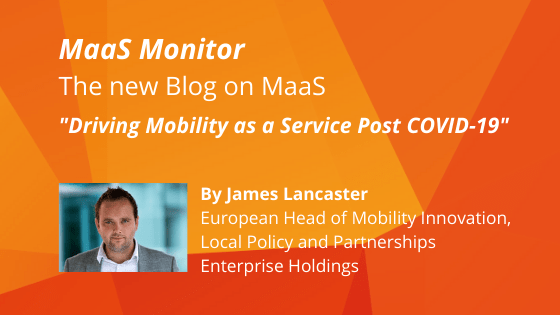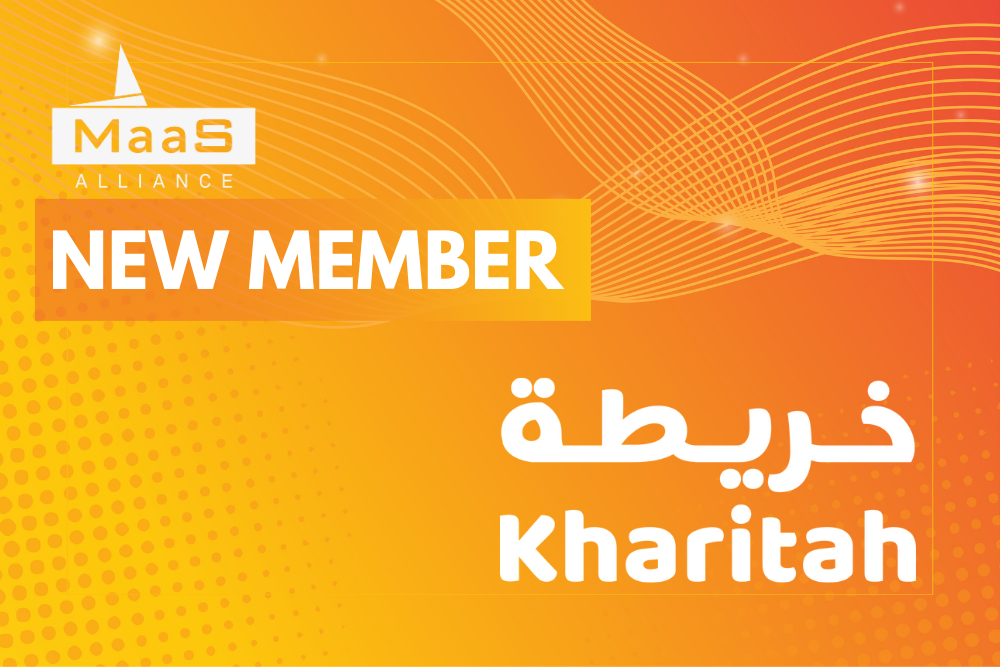
Blog post by James Lancaster, European Head of Mobility Innovation, Local Policy and Partnerships at Enterprise Holdings
The decarbonisation of transport is a key policy priority across the globe and in recent years, industry and policy makers have worked together to develop innovative solutions to address climate change and drive modal shift towards sustainable mobility. Covid-19 has had a devastating impact on public transport and there is a real risk that unless we can find and implement drivers that will ensure consumers return and increase their usage of public and shared mobility solutions, governments will struggle to deliver on their environmental ambitions, that have only amplified during the past 12 months.
If public authorities deploy large-scale Mobility as a Service (MaaS) programmes in an effective way that incentivises users, then this could be a key tool for getting people back on-board public transport and achieving widespread adoption of shared mobility. To do this there are going to need to be incentives which ensure that consumers are not only inclined to make use of sustainable alternatives but are trusting of public and shared mobility in a post-Covid world.
With the vaccine beginning to be successfully deployed across many countries and with the hope that restrictions will be significantly reduced by the end of 2021, this paper outlines some of the incentives which will drive MaaS uptake and how MaaS can help regain the trust in public transport and shared mobility.
Regaining trust to public transport and shared services Post-COVID-19
The mobility sector has been strongly hit by the COVID-19 crisis with a wide societal and economic impact. During the lockdown periods the transport demand in almost all affected countries has gone drastically down. The long-term impacts and their gravity are still difficult to predict; the most argued topics are the willingness of users to return to high capacity (high occupancy) mass transit systems and unforeseen consequences related to general economic uncertainties.
While this crisis was almost impossible to foresee, its consequences have included some positive aspects as well, such as an increase in cycling and the rapid take-off of remote working. These new habits might bring along a long-lasting impact on mobility patterns; for example, several studies have now indicated improved air quality and less emissions in major metropolitan areas. However, this does not diminish MaaS’s future role in moving people around.
MaaS can act as an enabler of new agility in the mobility sector – it brings a much-needed variety to the demand side and at the same time helps with optimisation of the supply side. MaaS operators, as the interface between users and mobility providers, are in a very good position to understand and match the demand and supply, based on the preferences of the users and the prevailing circumstances. Providing users with various public, private and shared mobility options and the optimised offering for every single journey MaaS can be a valuable asset in reconstituting the user’s trust to public and shared services. Also detailed up-to-date information on various options becomes more and more essential now as the importance of safety is hugely increasing.
With this in mind, resources should be put towards regaining the trust of the public by focusing on things that matter to customers and that encourage them to return to public and shared transport.
- Safety-first: MaaS can provide customers with information that gives passengers confidence on the measures taken to ensure their health and safety. It can provide loading information on bus capacity and at bus stop and can help balance demand, it can allocate on-demand services and waiting slots, it can manage a track and trace facility that offers all passengers assurances regarding the use of the transport environment.
- Personalisation: MaaS can offer alternative routes / modes, encourage off-peak travel and deliver service or location-based offers and incentives.
- Trustworthiness: MaaS should guarantee correct real time information, a high level of quality, have a strong reputation/brand and offer or point to reliable transport services with a fair pricing.
- Simplicity: an easy, user-friendly, convenient service offering single sign-on access with integrated information all along the trip to help the traveller in the decision-making process.
- Impartiality: MaaS must be non-discriminatory and provide access to all available mobility options, keeping in mind efficiency and sustainability over commercial profitability.
- Flexibility: MaaS must be able to adapt to changing traveller needs and thus should consider fair pricing and personal preferences.
Policies and Incentives
To develop integrated transport systems that help achieve ambitious environmental goals, it will be essential that the public and private sector work in partnership. Mobility as a Service is a vital part of those future transport systems but MaaS as a solitary or homogenous policy tool, would fail to realise its full potential.
Every city region has its own idiosyncrasies and local context, and it is clear that “one MaaS size” does not fit all. The first step is to define the main transport related issue or policy goal that the city would like MaaS to help with – this need to identify the issue or policy goal is ever more important post-Covid.
Incentives and marketing strategies can be helpful to accelerate MaaS uptake. Gamification and nudging [1] for example, are elements of motivational techniques to be used with rewards as an incentive for desired travel behaviour. A MaaS platform offers a unique opportunity to apply them in a personalised way connected to attributes of time, cost, and convenience.
Incentive options include:
- Promotional and/or push information; the user is pushed information on sustainable mobility alternative choices either at purchase phase or on trip.
- Financial incentives; for example, retail and leisure discounts, discount codes, free rides, taxation exemptions, discounts on added value services etc.
- City-wide loyalty schemes; this could include loyalty points won through the use of sustainable mode choices.
- Enhancing a socially responsible user profile; the user is motivated by awareness by the system of his/her socially responsible behaviour. Similarly, the user could be praised for an active and healthier mobility user profile; for example, by using a bicycle or walking rather than driving a private car.
- Trial offers for certain mobility solutions.
For example in the iMOVE MaaS project [2] in Manchester, gamification was used to encourage voluntary travel behaviour change by motivating the self-rewarding impulses and desires of the user to travel more sustainably rather than relying on the top-down approach in which travel behaviour change is compelled by dis-incentivisation (i.e. congestion charging) or restrictions on supply (i.e. reduced road space for traffic, higher parking charges, etc.). Gamification frequently, but not exclusively, takes advantage of digitisation and the increased use of smartphones and social media to amplify the experience.
Closely related to gamification as an element of motivational techniques is the use of rewards as an incentive for recognised good travel behaviour. An example where gamification and rewards or incentives have been used successfully with a high engagement rate, is the Beat the Streets [3] scheme developed in the UK by Intelligent Health. Beat the Streets encourages families to reduce their use of the private car by rewarding walking and cycling to school or work. Essentially, smart boxes, known as a ‘Beat Box’ are placed along identified walk/cycle routes. People are given smartcards to tap Beat Boxes along given routes over a period of time, which allow for recording individual active travel activity and useful data gathering. Schools and workplaces can also compete in teams which adds the gamification element by encouraging people to travel more actively than their contemporaries. By travelling sustainably, participants can earn points and win prizes or rewards. Further means of stimulating sustainable travel behaviour include bonus schemes, where travellers are rewarded for using shared or eco-friendly modes. Rewards must be considered carefully: different segments may respond to different types of rewards such as free or discounted travel, partner discounts, or the use of sports cars. It continues to be the case that convenience appears to be the highest motivation for uptake of mobility initiatives. This reiterates the need to carefully develop appropriate rewards and incentives and in developing this, mobility service providers have a role in understanding what drives consumer behaviour.
Mobility Credits
The provision of mobility credits is an excellent example of how to attract private car owners onto a MaaS platform. This policy concept was initially promoted by the Urban Mobility Partnership (UMP) in the UK as a mechanism to get high polluting cars off the road quickly by asking participants to scrap their older diesel cars (Euro 1 to 5) to access ‘credits’ over a set period to spend on appropriate shared transportation options; that include bike hire, car hire and car club. As an incentive to consumers, the credits offered exceed the market value of the car and can be used on a range of sustainable and efficient modes of transport to suit their lives. Depending on the local area, the credits would include bus, active travel initiatives such as bike share or hire, car club and daily rental, rail, and tram. The scheme could be delivered through MaaS applications, with additional rules introduced concerning length of vehicle ownership and vehicle type.
Mobility Credits in the West Midlands
The scheme is being piloted by Transport for the West Midlands and Coventry City Council as a means to reduce emissions by incentivising positive behaviour change in favour of other modes of transport over private car ownership. The reliance on private cars across the WMCA region is a leading contributor to air pollution, including harmful NOx emissions. It is estimated that a mobility credits scheme in the West Midlands would decrease car usage amongst participants by 70%, with an increase of 12% in bus use and smaller increases in car club, active travel, and train usage. The NOx emission savings would also be significant; analysis shows that an uptake of 70-100% in a mobility credits scheme would allow the West Midlands to reach within 15% of the EU Emissions limit. The Mobility Credits scheme could act as a game changing catalyst to improve air quality whilst encouraging a shift from private vehicles to more sustainable transport options.
In addition to these environmental benefits there are significant safety benefits, in having new safer daily rental and car club vehicles on the road, and reduced congestion will inevitably lead to fewer road accidents. Finally, mobility credits can have economic benefits by; firstly, being tailored to apply to groups, areas, or demographics to ensure maximum benefit and to reduce the impact of punitive measures on those who can least afford it. Secondly by benefiting local businesses through people engaging more with less congested city centres and providing increased revenues to public transport operators.
Network and Mobility Management
- Dynamic and smart curbside and parking management can be effective ways to support uptake of MaaS at local level. Dynamic curbside management, including curb-space booking for car share, van share and freight deliveries within regional and town centres can incentivise shift to use of sustainable modes and better utilisation of our existing assets, helping to support local high streets. A detailed study published by the International Transport Forum [4] looks at the potential for a shift away from curb use focused on street parking to more flexible allocation that includes pick-up and drop-off zones for passengers and freight. It also provides insights from a modelling exercise to quantify the impact of re-allocating curb space from parking to pick-up and drop-off zones.
- Combining data, information, and several mechanisms of traffic management with the mobility as a service’s ones, we can reach the desired high level of mobility management by focusing on and empowering the efficiency and sustainability of mobility. Predicting and adapting to passengers’ flow variations and needs, and even being in position to manipulate them with incentivization techniques could act as a means to regulate traffic flows, respond on the road network’s bottlenecks and handle sudden incidents in real time. It is also the key to planning traffic management measures in advance. Furthermore, the concept of MaaS also brings new subjects to the scope of traffic management as it expands beyond vehicles also covering users of public transportation, cyclists, and even walkers. [5]
Concluding Thoughts
In delivering and considering how MaaS can be used to regain the trust of consumers, policy makers must remain cognizant of their policy goals and the reasons for implementing MaaS. At the heart of this must be delivering a solution that suits consumer’s needs – a clear vision in achieving this will help define the policies and incentives that cities can use to help drive consumers back to shared and public transport post-Covid-19. Public and private sector collaboration to develop integrated networks and services that achieve environmental and societal goals can be supported by cross sector policies and incentives, but parties must ensure that they remain commercially viable. Without ensuring that, a MaaS solutions suits the consumers’ needs or remains commercially viable, MaaS will fail to realise its potential as a solution to congestion, poor air quality and in the context of Covid, delivering consumers back to public and shared transport`
[1] From Game Design Elements to Gamefulness: Defining Gamification. Conference Paper, Detering ,S. et al, September 2011
[2] Sustainable MaaS Business Models: A Typology, iMOVE EU Project, July 2018
[3] https://www.beatthestreet.me/
[4] The Shared-Use City: Managing the Curb, OECD/ITF, May 2018
[5] https://tm20.org/wp-content/uploads/2020/10/TM-2.0-Maas-Alliance-report-for-Task-Force-on-Multimodal-mobility-final….-4.pdf
James Lancaster – European Head of Mobility Innovation, Local Policy and Partnerships, Enterprise Holdings
As Head of Mobility Innovation, Local Policy and Partnerships, James Lancaster is responsible for working with Enterprise Holdings’ five European corporate markets in their development of new mobility services in partnership with local governments and transport authorities. He works to scale up successful initiatives in the UK and expand them across the company’s European markets to facilitate Enterprise’s growth as a provider of municipal mobility services.
James joined Enterprise in 2017 to establish the company’s UK and Ireland Government Affairs department, where he led the development, management, and delivery of the team’s public affairs strategies across national and devolved administrations. He also managed industry engagement and developed policy initiatives to support the commercial objectives of the business.
During his time at Enterprise, James has been involved in extensive conversations with national and local government about the implementation of clean air zones and the transition towards Mobility as a Service and transport on-demand. He has also worked closely with several leading transport and insurance trade bodies.
In 2018, James established the Urban Mobility Partnership in the UK, which he now chairs and was successful in securing more than £90 million in funding for UK cities to promote sustainable travel.
Enterprise Holdings
Enterprise Holdings is the world’s largest privately-owned mobility company. It operates more than 1.9 million vehicles worldwide, 10,000 fully-staffed offices across the globe and is available in 100 countries. Across Europe, Enterprise has more than 1,200 locations employing more than 10,000 people, covers more than 200 airports and has a fleet of more than 200,000 vehicles.
Part of Enterprise Holdings, Enterprise Rent-A-Car is an industry leading, multinational car rental and leasing company. Our service also includes Enterprise Car Club; a natural extension of the local car-rental service that enables users to book cars that are part of Enterprise Car Club’s fleet offering a cost-effective alternative to owning a vehicle. This type of shared transport service not only provides an alternative to private vehicle ownership where this proves more environmentally friendly and cost-efficient for consumers.
Enterprise has also become a global leader in the future of mobility and has invested over $2 billion in mobility innovations in the last few years. Enterprise is looking to develop innovative solutions which can help develop the transport system of the future which reduces the reliance on the most polluting forms of transport.



